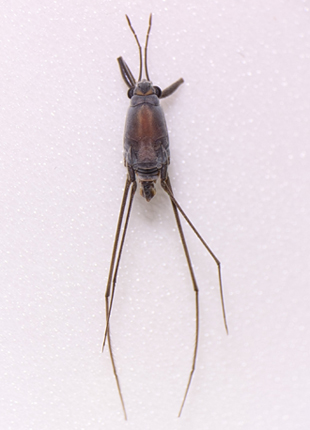- UMDB Top >
- Entomology >
- Introduction >
- Ikawa Sea-Skater Collection Part1
Terumi Ikawa Sea-Skater Collection, Part 1

Introduction

Dr. Terumi Ikawa, Professor Emeritus of the Faculty of Literature, Morioka University, is a marine entomologist renowned for her research on sea skaters. In 2020, her extensive collection was donated to the University Museum, The University of Tokyo. Comprising approximately 20,000 specimens, the majority of this collection consists of pelagic Halobates species, which are typically collected during marine expeditions aboard research vessels. Boasting an unparalleled number of specimens even on a global scale, this collection constitutes a highly valuable scientific resource.
Sea skaters possess unique ecological adaptations to marine environments and are the only known insects inhabiting not only coastal areas but also the open ocean. Dr. Ikawa has conducted extensive studies on their ecology and life history, with particular emphasis on the effects of oceanic dispersal in offshore species. For instance, through field surveys and rearing experiments on coastal species such as Asclepios shioensis, Halobates sericeus, and Halobates japonicus, she has elucidated survival and overwintering strategies associated with tidal dynamics (e.g., Ikawa & Nakazawa, 2015; Ikawa et al., 2018). For pelagic species, she has investigated the role of oceanic dispersal in forming their distribution patterns and encounter frequencies using mathematical modeling approaches (Ikawa et al., 1998).
Part I of this catalogue presents a portion of the database derived from the Ikawa Collection, specifically focusing on species distributed along the Japanese coastline. It includes comprehensive developmental stage data for nymphs of Halobates and Halovelia species, all of which are preserved in ethanol and thus remain in excellent condition. Species identification and taxonomic nomenclature follow the standards of Esaki (1924) and Herring (1961).
The release of this database is expected to provide a valuable resource for researchers both in Japan and abroad working in fields such as marine biology, evolutionary biology, and biogeography. Moreover, the distributional data of oceanic water striders may also contribute to studies on marine environmental change and biodiversity conservation.
Acknowledgments
The compilation of this catalogue would not have been possible without the assistance of numerous collaborators who helped collecting the specimens. This work was supported by a JSPS Grant-in-Aid (JP24HP7006) and the UTokyo Digital Archives Project. We gratefully acknowledge their generous support.
References
- Ikawa, T. & Nakazawa, A., 2015. Life history of an endangered marine insect Halovelia septentrionalis Esaki (Hemiptera: Veliidae). Psyche: A Journal of Entomology, 2015 (1): 712093.
- Ikawa, T., Nozoe, Y., Yamashita, N., Nishimura, N., Ohnoki, S., Yusa, K., Hoshizaki, S., Komaba, M. & Kawakubo, A., 2018. A study of the distributions of two endangered sea skaters Halobates matsumurai Esaki and Asclepios shiranui (Esaki) (Hemiptera: Gerridae: Halobatinae) with special reference to their strategies to cope with tidal currents. Psyche: A Journal of Entomology, 2018 (1): 3464829.
- Ikawa, T., Okubo, A., Okabe, H. & Cheng, L., 1998. Oceanic diffusion and the pelagic insects Halobates spp.(Gerridae: Hemiptera). Marine Biology, 131: 195–201.
- Esaki, T., 1924. On the genus Halobates from Japanese and Formosan coasts (Hemiptera: Gerridae). Psyche: A Journal of Entomology, 31 (2): 112–118.
- Herring, J. L., 1961. The genus Halobates (Hemiptera: Gerridae). Pacific Insects, 3 (2/3): 223–305